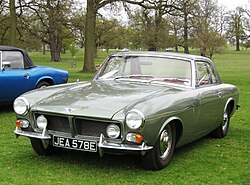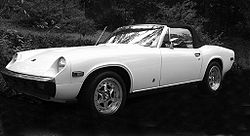Jensen P66
| Jensen | |
|---|---|

|
|
| P 66 | |
| Presentation year: | 1965 |
| Vehicle fair: | Earls Court Motor Show |
| Class : | Sports car |
| Body shape : | Coupé , convertible |
| Engine: |
Otto engine : 6.3 liters |
| Production model: | none |
The Jensen P66 was a two-door Gran Turismo from the British sports car and body manufacturer Jensen Motors , which was developed from 1964. The model was to succeed the Austin-Healey 3000 produced by Jensen, but its realization was abandoned after the production of two prototypes.
Development history
Jensen Motors, founded in 1931, was primarily a body manufacturer for established British car factories. After the company had outfitted some vehicles individually according to customer requirements in the 1930s - including a Ford V8 for Clark Gable - it shifted its focus to the industrial series production of bodies before the start of the Second World War . After the end of the war, Jensen produced around 4,000 copies of the Austin A40 Sports , later Jensen produced the body shells for the Austin-Healey 100 , the Sunbeam Tiger , the Volvo P1800 and the Austin-Healey 3000. In addition, since 1936 a number of sports cars have been built under their own names were marketed. After the war these were the "Early Interceptor" , the 541 and the C-V8 . These were high-priced luxury coupés that were issued in small series and, taken in isolation, usually resulted in losses for the company.
In the mid-1960s, the company was primarily responsible for the production of the bodies for the Austin-Healey 3000, of which more than 42,000 copies were made in eight years. The Jensen C-V8, equipped with an American eight-cylinder engine from Chrysler, played only a very subordinate role with a total production of 500 units in five years. When production of the Austin-Healey 3000 was approaching in the mid-1960s, the Jensen management looked for an alternative to utilize the existing capacities at the West Bromwich plant.
In the absence of an alternative third-party contract, the company decided to develop its own sports car, which should be positioned in the market niche of the Austin-Healey and thus located below the large and expensive C-V8. This project was called the Jensen P66 in-house. The development of the technology and the structure took the year 1964 to complete. In 1965 two prototypes were made - a closed four-seater and a convertible - which were presented to the public at the Earls Court Motor Show in London in autumn 1965 . At this point in time there were already sales brochures for the P66. Allegedly, 1000 orders from interested customers followed the presentation.
Following the performance, there were internal discussions about the positioning and the future of the P66. While company founders Richard and Alan Jensen endorsed the P66 as an Austin-Healey replacement, other parts of the company's management, particularly chief engineer Kevin Beattie, saw the need to replace the outdated, higher-end C-V8. In addition, the in-house designed body of the P66 was perceived as old-fashioned and unattractive. Beattie was helped on this matter by the Norcros Group , a shareholder in Jensen Motors. In the spring of 1966, when Richard Jensen was hospitalized for a heart attack, Beattie commissioned the Italian Carrozzeria Touring to design a new luxury coupé that would take on the role of the C-V8. This ultimately resulted in the Jensen Interceptor , whose series production began that same year. The decision in favor of the Interceptor meant the end of the P66. As a result, Richard and Alan Jensen and Eric Neale, the creator of the P66, left the company.
technology
The Jensen P66 was developed under the direction of long-time Jensen employee Eric Neale. Neale designed a new lattice frame for the P66 that was narrower and lighter than the C-V8's chassis. Unlike the 541 and the C-V8, whose bodies were made of plastic , the structure was made of aluminum . Three eight-cylinder engines of different sizes from Chrysler were provided for the drive. In addition to the 6.3 liter engine, which was also used in the C-V8, smaller versions with 5.9 and 4.5 liters displacement should also be available. The front wheels were individually suspended and had coil springs , while a De-Dion axle with semi-elliptical leaf springs was provided at the rear . Power was transmitted via a three-speed automatic from Chrysler.
The body of the P66 was also designed by Eric Neale. The design was based on Italian sports coupes; Observers saw similarities with the Maserati 3500 GT (which was built in 1957), particularly in the area of the front end . The front fenders each ended in a round headlight, the front line of the bonnet was slightly lowered in comparison. The roof of the coupé was shaped like a trapezoid; it had three side windows.
Further development
Jensen produced several thousand copies of the Interceptor from 1966 to 1976, which was offered as a saloon, a convertible and a notchback coupé. The role of the P66 as an inexpensive model in the Austin-Healey market segment was taken over by Jensen-Healey in 1972 , of which around 10,000 were made until the company went bankrupt in 1976.
The coupe version of the P66 still exists. It stood in the US for some time in the 1990s before it was bought by a collector in the UK. One of the prototypes served as a test vehicle for the all-wheel drive of the later Jensen FF .
literature
- Rainer W. Schlegelmilch, Hartmut Lehbrink: English sports cars . Könemann, Cologne 2001. ISBN 3-8290-7449-2 .
- John Tipler: Jensen Interceptor. The Complete Story . Crowood Press Ltd., Ramsbury 2004. ISBN 978-1-86126-711-5
- Nick Walker: AZ of British Coachbuilders , Bayview Books, Beaworthy (Devon), 2007, ISBN 978-0-9549981-6-5
Web links
Sales brochure for the Jensen P66 from 1965
Individual evidence
- ↑ For the history of the company, cf. Nick Walker: AZ of British Coachbuilders , Bayview Books, Beaworthy (Devon), 2007, ISBN 978-0-9549981-6-5 , p. 131.
- ↑ John Tipler: Jensen Interceptor. The Complete Story . Crowood Press Ltd., Ramsbury 2004. ISBN 978-1-86126-711-5 , p. 35.
- ↑ To the whole: John Tipler: Jensen Interceptor. The Complete Story . Crowood Press Ltd., Ramsbury 2004. ISBN 978-1-86126-711-5 , pp. 38-42.
- ↑ On the whole cf. the technical information in the sales prospectus from 1965 (accessed on October 18, 2013).
- ^ A b John Tipler: Jensen Interceptor. The Complete Story . Crowood Press Ltd., Ramsbury 2004. ISBN 978-1-86126-711-5 , p. 38.
| Vehicle class | Body versions | 1930s | 1940s | 1950s | 1960s | 1970s | 1980s | 1990s | 2000s | |||||||||||||||||||||||||||||||||||||||||||||||||||||||||||
| 6th | 7th | 8th | 9 | 0 | 1 | 2 | 3 | 4th | 5 | 6th | 7th | 8th | 9 | 0 | 1 | 2 | 3 | 4th | 5 | 6th | 7th | 8th | 9 | 0 | 1 | 2 | 3 | 4th | 5 | 6th | 7th | 8th | 9 | 0 | 1 | 2 | 3 | 4th | 5 | 6th | 7th | 8th | 9 | 0 | 1 | 2 | 3 | 4th | 5 | 6th | 7th | 8th | 9 | 0 | 1 | 2 | 3 | 4th | 5 | 6th | 7th | 8th | 9 | 0 | 1 | 2 | ||
| Upper class | limousine | S-type | PW | |||||||||||||||||||||||||||||||||||||||||||||||||||||||||||||||||
| H-type | ||||||||||||||||||||||||||||||||||||||||||||||||||||||||||||||||||||
| Coupé / convertible | S-type | |||||||||||||||||||||||||||||||||||||||||||||||||||||||||||||||||||
| H-type | ||||||||||||||||||||||||||||||||||||||||||||||||||||||||||||||||||||
| Sports car | Coupé / convertible / roadster | Interceptor | C-V8 | SP | GT | |||||||||||||||||||||||||||||||||||||||||||||||||||||||||||||||
| 541 | Interceptor | Interceptor | S-V8 | |||||||||||||||||||||||||||||||||||||||||||||||||||||||||||||||||
| FF | Healey | |||||||||||||||||||||||||||||||||||||||||||||||||||||||||||||||||||

